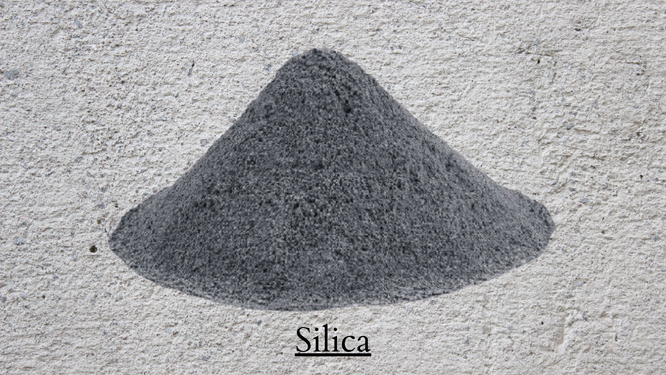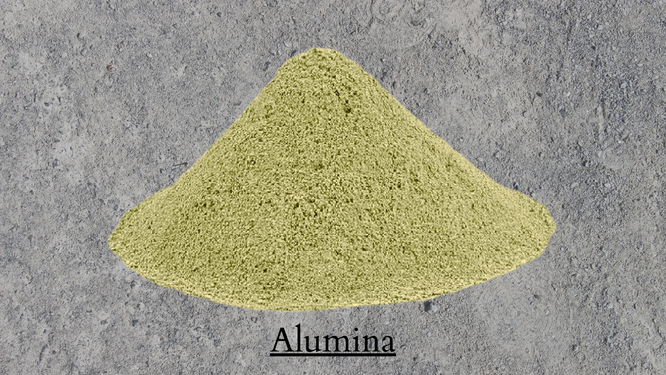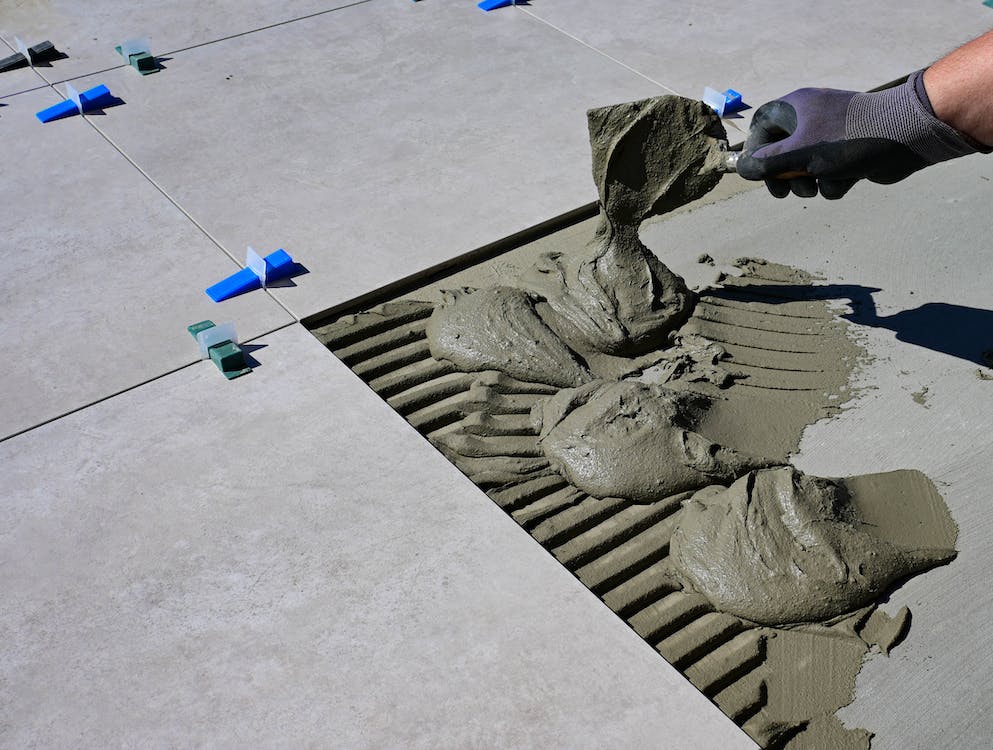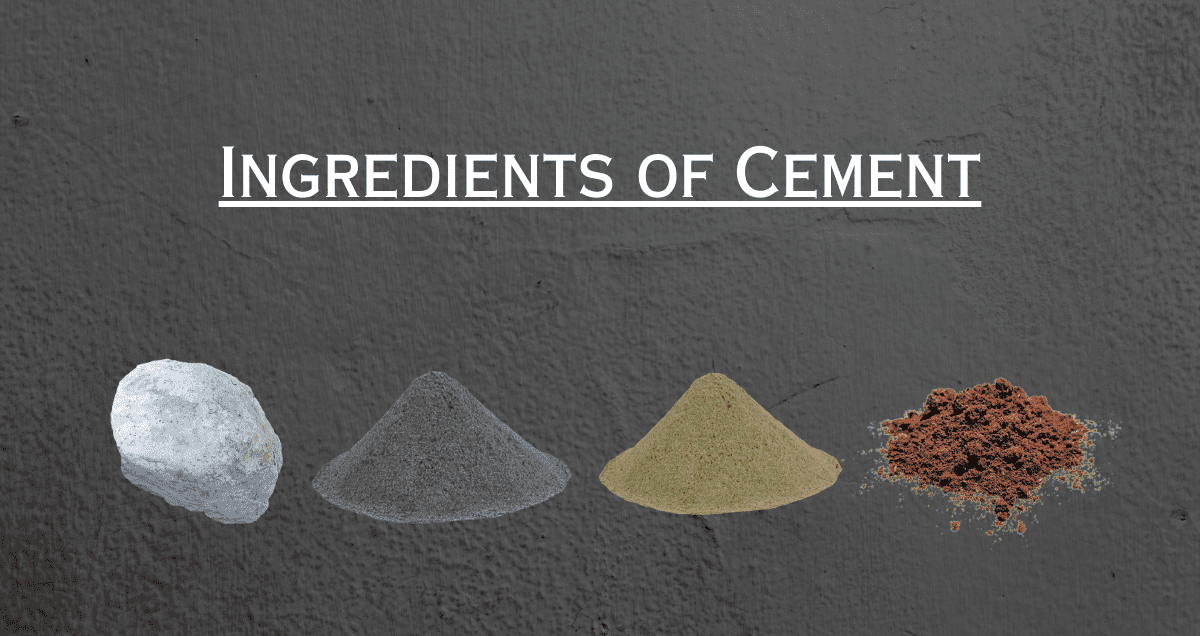Ingredients of cement
Ingredients of cement play an important role in the properties of the cement. Every construction work is almost incomplete without cement. Cement is a primary binding material used in the construction industry. It is used to bind the aggregate in the concrete. So it is necessary for civil engineers to learn about the ingredients of cement which is the essential material of the construction industry.
The main ingredients of cement and their proportions are discussed below:
Lime (Cao)

This is the important ingredient of cement and its proportion is to be carefully maintained. It occupies the percentage of 60-67%. The lime in excess makes the cement unsound and causes the cement to expand and disintegrate. On the other hand, if lime is in less amount than the required amount, the strength of the cement is decreased and it causes the cement to set quickly.
Silica (SiO2)

Silica is obtained from sand, argillaceous rock, etc. It is the main ingredient of cement and it provides strength to the cement due to the formation of di-calcium and tri-calcium silicates. It is about 17-25% in cement. The strength of cement increases when silica is added in excess, but as a result, cement takes longer to cure.
Alumina (Al2O3)

Alumina is obtained from bauxite, alumina contains clay, etc. It is added to cement during the manufacturing process to enhance its properties and performance. The presence of alumina in cement can affect its setting time. It has a range of about 3 to 8%.
Alumina has a retarding effect on the setting process, which means it can slow down the initial and final setting times of cement. Higher alumina content generally leads to increased heat of hydration.
However, the high temperature is essential for the formation of a suitable type of cement and hence the aluminum should not be present in excess amount as it weakens the cement.
Calcium Sulphate (CaSo4)
This ingredient is in the form of gypsum and its function is to regulate the setting time of cement. The proportion of gypsum in cement is usually around 3% to 4%. Its role is to control the speed at which the cement hardens, allowing for proper workability and curing.
Iron Oxide (Fe2 O3)

This ingredient imports color, hardness, and strength to the cement.
Magnesia (MgO)
This ingredient if present in small amounts in parts hardness and color to the cement a high content of magnesia makes the cement unsound.
Sulphur (S)
A very small quantity of sulfur is useful in making sound cement. If it is in excess, it causes cement to become unsound.
Alkalies
Most of the alkalis present in raw material are carried away by the flue gases during heating and the cement contains only a small amount of alkalis. If they are in excess in cement, they cause several troubles such as an alkali-aggregate reaction, efflorescence, and staining when used in concrete, brickwork, or masonry mortar. Soda and potash are alkalis ranging from 0.2-1%.
Harmful Ingredients of Cement
It is essential to know about the harmful ingredients of cement that may be present and adversely affect the quality of the cement. Following are the two oxides of the cement:
- Alkali oxides K2O and Na2O
- Magnesium oxide MgO
Aggregates in concrete react with the alkalis present in cement, resulting in the formation of a gel-like substance. This gel can expand, leading to cracking and reduced durability of concrete structures.
If the alkali content is greater than 1 percent, it causes the failure of concrete made from that cement. So, it is advised to use low-alkali cement and the right aggregates.
Similarly, if the content of magnesium oxide exceeds 5%, it causes cracks after mortar or concrete hardens. It is because magnesium oxide, burned at a temperature of about 1500°C, slakes very slowly when mixed with water.
Setting Action of Cement
When water is introduced to cement, the chemical reactions between the ingredients of cement and the water result in a variety of complex chemical combinations. These compounds do not form simultaneously. But the cement takes a long time to set.

Photo by Vladimir Srajber from Pexels
It is found that ordinary cement achieves about 70% of its final strength in 28 days and about 90% of its final strength in one year or so.
The following are the important compounds formed during the setting action of cement:
- Tricalcium aluminate (3CaO, Al2O3): This compound is formed within about 24 hours after the addition of water to the cement.
- Tetra-calcium alumino-ferrite (4CaO, Al2O3, Fe2O3): This compound is also formed within about 24 hours after the addition of water to the cement.
- Tricalcium silicate (3CaO, SiO2): This compound is formed within a week or so after the addition of water to the cement and it is mainly responsible for imparting strength to the cement in the early period of setting.
- Dicalcium silicate (2CaO, SiO): This compound is formed very slowly and hence it is responsible for giving progressive strength to the cement.
The following table shows the percentage of relative proportions of the abovementioned four main minerals in typical Portland cement, expressed as:
| C3A | 4 to 14 |
| C4AF | 10 to 18 |
| C3S | 45 to 65 |
| C2S | 15 to 35 |
When water is added to the cement, the quickest to react with water is C3A, and in order of decreasing rate are C4AF, C3S, and C2S.
During the initial period of hardening, the gain in strength of C2S is small and it is about 15 percent to that of C3S. After 28 days, the hydration of C3S comes practically to an end and the hydration of C2S only really begins at that time.
Hence when a high-strength concrete is required within a short period of time, the cement is made with a high content of C3S. However, if high-strength concrete is needed afterward, like in the case of constructions for hydraulic engineering, the cement is prepared with a high amount of C2S.
The hardening of concrete is highly speeded by C3A and hence this property of C3A is utilized for producing quick-hardening Portland cement.
Portland cement can be generally divided into the following categories according to the percentage of the clinker’s mineralogical composition:
| Alit, containing C3S more than | 50 to 60% |
| Aluminate, containing C3A more than | 12% |
| Alumoferrite, containing C3A less than | 2% |
| C4AF more than | 18% |
| Belit, containing C2S more than | 35% |
| High-alit, containing C3S more than | 60% |
FAQs
What are the main ingredients of cement?
The main ingredients of cement are limestone (calcium carbonate), clay (silica and alumina), iron ore, and gypsum (calcium sulfate).
Which chemical is used in cement?
It consists of four main compounds tricalcium aluminate (3CaO · Al2O3), and a tetra-calcium aluminoferrite (4CaO · Al2O3Fe2O3), tricalcium silicate (3CaO · SiO2), dicalcium silicate (2CaO · SiO2).
How does cement set?
Cement sets through a process called hydration, where water combines with the ingredients of cement to form compounds that harden over time.
What are the harmful constituents of cement?
Harmful constituents in cement include alkali oxides (K2O and Na2O) and magnesium oxides (MgO), which can lead to concrete deterioration.
Also read:
13 Best Types of Cement For Concrete Mix Types of Steel Reinforcement Properties and Uses Reinforced Cement Concrete Properties, Uses, Advantages |Full Detail|


